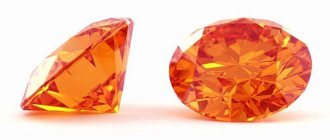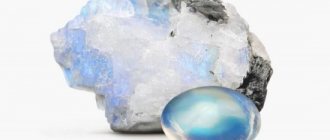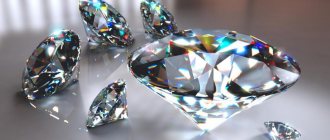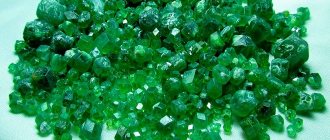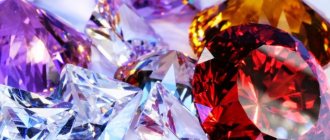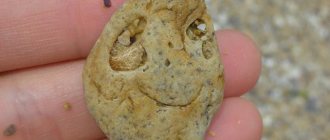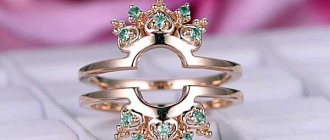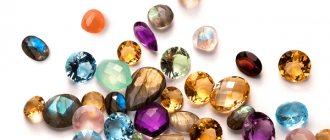Group of organic stones
Geologists, collectors and jewelers evaluate and classify stones in different ways. For jewelers, transparency and brilliance are important; for mineralogy, the chemical composition of the nugget is important. Collectors look at the value of the mineral and its rarity in nature. Thus, in different years, different classifications were used, according to which stones were assigned to one group or another.
In 1896, Max Bauer proposed dividing all gems into three types: precious stones, semi-precious stones, and stones of organic origin. It is the third group that we will talk about in this article.
Organic stones were formed mainly as a result of the petrification of living nature. These include corals, amber, pearls, jet and others. The mesmerizing beauty of these specimens has delighted people for several millennia. They are used to create jewelry; large samples with unique colors or sizes are sold at auctions or placed in the best museums in the world. Thanks to such finds, historians can clearly see what living creatures inhabited our planet in ancient times.
Organic stones
Stones that arise as a result of the vital activity of living organisms are called organic. These include pearls, amber, coral, jet and mother of pearl.
Pearls are a hardened form of calcium carbonate. Often pearls have a translucent hue and a round shape, but there are also specimens of irregular shape. This organic stone is quite fragile and is not resistant to heat. The color of pearls is white with a bluish or yellowish tint; yellow, pale pink, grey, reddish, black, light brown, pale green and light blue.
Since ancient times, pearls have been classified as jewelry. According to the environment of formation, natural pearls are divided into river and sea pearls. There are also cultured sea pearls, which are grown under artificial conditions. But it is only possible to distinguish natural pearls from cultured ones using X-rays.
Pearls are used to make necklaces and beads, as inserts in the manufacture of rings, brooches, and necklaces. Pearls look especially beautiful in combination with diamonds.
Amber is a fossilized transparent (or translucent) resin that has an amorphous structure. Inclusions in this fossil resin can be very different - grains of sand, remains of wood and leaves, flower petals and even fossilized insects.
Amber polishes quite well and has a fairly strong “oily” sheen. Amber comes in a variety of warm shades ranging from pale yellow to brownish red. There are specimens with white, blue, green, golden and pink shades.
Amber is used as an independent decoration in the form of beads, or in combination with gold, silver and non-precious alloys to create any kind of jewelry.
Coral is also an organic rock that represents the skeleton of polyps - marine invertebrates. Coral is an opaque material with a waxy sheen. It is not as fragile as amber or pearls, but it is also easy to break.
The most common color of coral is white, but there are red (including dark), black and orange shades. Pink corals are considered the most valuable. Coral can be a decoration in itself or used as an insert to create jewelry made from precious and base metals.
Jet is a valuable type of fossil black coal. This organic stone has a dense structure, it is homogeneous and viscous - which makes it easy to process. Jet polishes well. After cutting, it is used as inserts in the manufacture of jewelry. Bracelets and rings are also cut from jet.
Mother of pearl is obtained from mollusk shells - the inner layer of the shells. This organic substance has a pleasant iridescent sheen. In nacre, unlike pearls, the crystals of the substance are located parallel to the surface, so the thickness of nacre is usually small. Mother of pearl is used to make cufflinks, watch dials, earring inserts, necklaces and brooches.
posted by Galina | | publish your technique
| Tweet |
<< previous techniquenext technique >>
Types of organic stones
Why do some types of organic matter become fossilized? What processes occur in this case? There are several types of organic fossils, each of which has its own characteristics during formation, and also differs in external characteristics. Let's look at the most popular formations in this group:
- Ammonites;
- Ivory;
- Nacre;
- Coral;
- Amber;
- Pearl;
- Jet;
- Petrified wood;
- Devil's finger (belemnitis).
The stones listed above are radically different from each other. At first glance, it is even difficult to imagine why they were combined into one group. Some of them were formed from plants, which, due to external factors over several millennia, formed amazing nuggets. Others were formed in a much shorter time by separating organic substances from living mollusks.
Assessment of the quality of jewelry stones of organic origin
Natural jewelry stones can be of mineral or organic origin. The latter include pearls and amber. Amber is a fossil resin from coniferous trees of the Tertiary period. Its hardness is low and amounts to 2.5 on the Mohs scale [1, p.271].
Often, amber jewelry offered on the commodity market is an imitation and fake. Synthetic resins are used for their production. Usually, an inclusion is also placed in a fake - an internal inclusion that increases the cost of the stone several times. The work has developed a set of techniques that makes it easy to identify fake amber and distinguish them from natural ones. The appearance of the studied amber samples is shown in Fig. 1. The set of methods includes: estimation of density in salt water and by the hydrostatic method, combustion of the sample, assessment of electrification, and the notch method.
Fig.1 Study samples of amber items
Density estimation. Amber is known to have the lowest density of all precious and semi-precious stones. The density of natural amber is less than the density of sea water. When natural amber is placed in a glass of water with 10 teaspoons of salt dissolved, it floats. All imitations, except polystyrene, have a high density, so they sink. Figure 2 shows the behavior of a natural amber sample and an imitation sample in a salt solution in water. In clean water, both amber samples sink (Fig. 3). The density of natural amber, according to reference data, is 1.05–1.09 g/cm3. The studied samples of natural amber had a density, determined by the hydrostatic method, of 1.08 g/cm3. The density of the studied imitations samples was 1.25 g/cm3.
a b
Fig.2 Behavior of the studied samples in a salt solution in water:
a - a sample of natural amber; b – sample of imitation amber.
a b
Fig.3 Behavior of the studied samples in clean water:
a - a sample of natural amber; b – sample of imitation amber.
Burning the sample. Amber, being a resin, burns well, releasing a specific rosin smell. A sample of natural amber, after entering the flame, lights up within 3 seconds; after the flame is withdrawn, the stone continues to burn with a large flame. When burning, black smoke is released, and the smell of rosin is clearly felt. Counterfeits made of polystyrene melt. If, after the initial melting, the counterfeits do catch fire, they burn with a smoky flame, and an unpleasant, pungent odor is released.
a b
Fig.4 Combustion of the studied samples:
a - a sample of natural amber; b – sample of imitation amber.
Electrification. If a sample of natural amber is rubbed on a woolen cloth and brought to finely cut tissue paper, then pieces of paper are attracted to the sample, and thin wool fibers also behave. This does not happen with samples - imitation. Figure 5 shows the attraction of wool fibers to electrified natural amber
Incision method. When a knife blade is drawn across a strip on the surface of natural amber samples, small crumbs are formed. In some types of imitations, in such cases, twisted chips are obtained.
Pearls are organic deposits (composition: 86-90% CaCO3; 12-6% organic matter and water) of mollusks in shells. It has a low hardness (2.5-4.5) and requires careful handling. There are natural (natural) pearls and cultured, sea and river pearls. Pearls come in various shapes and colors [2, p.202].
The quality of a pearl depends on its shape and color, size and shine. The correct spherical shape is valued more highly. Semicircular pearls are flat on one side called
are made with “buttons”, asymmetrical specimens are “Baroque”. The weight of a pearl is measured in grains (0.05 g
=0.25
carats
) or carats. The value of a pearl is determined according to the following scheme: the weight is squared and multiplied by a coefficient (from 1 to 40), taking into account quality, size, shine and other factors affecting the price.
Fig.5 Attraction of wool fibers to electrified natural amber.
The designation "pearl" without additives can only be used for natural pearls; cultured pearls must be designated as such. It is very important to distinguish between natural and cultured pearls, as their prices differ greatly.
Various methods are used to assess the quality of pearl products [3, p. 85]: rebound from a hard surface (natural pearls bounce off glass with a ringing sound, unlike cultured ones); crushing against wood (natural pearls, when crushed against wood, remain intact, but imitations crumble and break); irradiation (cultured pearls exhibit yellowish luminescence when exposed to ultraviolet irradiation, and green when exposed to x-rays); determination of density (the density of cultured pearls is above 2.73, while natural pearls are often below this value); checking the internal structure (natural pearls have a concentric-zonal structure, cultured pearls have a different structure, depending on the type of core consisting of nacre, coating thickness - 0.5 mm
); assessment of luster (the coating of a cultured pearl transmits light more strongly than the substance of a natural one, and has a waxy sheen; diameter of the hole (the hole in cultured pearls is usually larger in diameter, and around the hole chips are often visible and the border between the shell and the core is noticeable); coloring (pearls can be painted with dyes : black pearls are treated with nitrogen silver to improve color uniformity, and natural ones are rarely truly black, more often bronze, metallic gray or blue-black with iridescence; tooth test (the tooth slides over the imitation and “clings” to the rough surface of natural pearls: on the surface of the imitation there are no lines of growth layers and granular structures inherent in natural pearls).
Literature
1. Moiseenko N.S. Merchandising of non-food products. - Rostov n/D: Phoenix, 2005. - 336 p.
2. Moiseenko N.S. Merchandising of non-food products. - Rostov n/D: Phoenix, 2003.-288p.
3. Dvorova N.V., Morozova E.A., Muratov V.S. Analysis of methods for assessing the quality of pearl jewelry. Materials of the III scientific international conference “Modern problems of science and education”. Modern high-tech technologies - M.: “Academy of Natural Sciences”, 2008, No. 4, p. 85-86.
Organic formations from shellfish
Ammonites
Hundreds of millions of years ago, during the time of dinosaurs, molluscs called ammonites lived in the ocean. Their amazing shells, curled with a ram's horn, have been preserved to this day. However, geologists sometimes find them far from water. This is due to the fact that in past eras the seas were located in other places. Some samples of whole ammonites are gigantic in size - the largest of them weighs more than 3 tons, its diameter is 1.5 meters. The most valuable are fossilized ammonites with remains of mother-of-pearl on the surface. Jewelers often use these fossils in various types of jewelry. Some types are processed in such a way that the mother of pearl covering the inside of the shell favorably emphasizes the beauty of the nugget. In other specimens, on the contrary, the emphasis is on the beauty of the patterns formed from limescale.
Devil's finger (belemnite)
Belemnite mollusks also lived in the Jurassic and Cretaceous periods. Visually, they are similar to squids, but they had a shell that consisted of the following parts: phragmocone, proostracum and rostrum. The last part was the strongest and looked like a pointed cylinder. It is this part of the shell that has survived to this day and is one of the types of organic fossils. Looking at the shape of the fossil, belemnite got its middle name - devil's finger. The average length of the rostrum is 20 cm, some finds measure 50 cm.
Nacre
An organic formation called mother-of-pearl is also incredibly beautiful and durable. It represents the inside of the shell in which the pearl is formed. That is why the stone received such a name - in German “Perl Mutter” means “mother of pearls”. A distinctive feature of the nugget is its variety of shades and incredible shine. Creating jewelry from mother-of-pearl requires high professionalism of the craftsman. The gem consists of calcium carbonate, water and organic compounds secreted by shellfish.
Pearl
Despite the variety of marine fossils, it is safe to say that pearls are the most valuable and unique. It can form in some types of shells - marine or freshwater. When a foreign body gets inside, the mollusk begins to secrete secretions, with the help of which it protects itself from “uninvited guests.” The coated layers have a delightful pearlescent sheen. Different types of pearl oysters have different secretions that differ in color. Thus, the most expensive is considered to be black pearls, which are created by oysters of the species Pinctada margaritifera; they live in the Hawaiian Islands - Figure 1.
Given the enormous popularity of pearls, experts have created entire farms that grow organic stone. They independently implant small grains of sand into the shell, after which the work of the mollusk begins. It takes about 10 years to create an average-sized pearl.
Organic gemstones
Pearl.The beginning of the use of pearls as jewelry, like many precious stones, is lost in ancient times. Pearls were in great fashion in Ancient Egypt and Rome. In Rus', pearls were used to decorate church vestments, vestments, clothing and headdresses of boyars, princes and members of their families.
Under natural conditions, pearls are formed in the shells of some pearl mussels when foreign objects enter the shell: grains of sand, various parasites, etc., causing disturbance to the animal. In this regard, the Japanese say that pearls are the tears of a mollusk. As a form of self-defense, the mollusk gradually deposits calcium carbonate and an organic adhesive substance that cements it, conchiolin, around the foreign body that interferes with it, and in this way, after a few years, a pearl appears.
In terms of its chemical composition, pearls, like nacre, consist on average of 90% calcium carbonate CaCO3*, 5% horny organic mass and 3% water. Both in pearl and nacre, calcium carbonate is deposited in the form of the thinnest plates of calcite and radial aragonite needles, which, in combination with the adhesive organic mass, gives a peculiar rainbow play to the reflected light. The difference between pearls and mother-of-pearl lies in the ratio of these two crystalline forms of calcium carbonate and depending on the quality of the horny organic mass that cements pearls and mother-of-pearl. Pearl is formed mainly from aragonite, and mother-of-pearl is formed mainly from calcite. In addition, the deposition of layers in pearls is concentric, while in nacre it is parallel. Pearls are mined in places where pearl-bearing mollusks are widespread, of which there are more than thirty species. Typically, pearl mussels settle on the shallows of seas and oceans, at a depth of 6-10 m, from where they are harvested. Some species of pearl-bearing mollusks live in the northern rivers of the USSR and Finland. Pearls are harvested by simply catching pearl-bearing shells. Only a few of the shells caught contain pearls, and the catch averages only a few carats per hundred pearl mussels caught. Pearls come in different sizes, shapes and weights. Large pearls are very rare and are as historically rare as large diamonds. Pearls weighing 134 and 126 carats were known. These pearls once belonged to the Spanish kings.
* (Calcium carbonate has the ability to crystallize in the form of two crystalline varieties: calcite and aragonite. Usually calcium carbonate crystallizes in the form of calcite, since this crystalline form is the most stable for it under natural conditions.
)
Pearls are not as durable as gemstones. Over time, pearls dry out, lose their attractiveness and eventually turn into a powder consisting of lime and the remains of organic horny matter. According to jewelers, the lifespan of a pearl is no more than 150 years, and the drying process begins much earlier. The high cost of pearls has prompted the search for ways to cultivate them artificially. The first attempts to obtain artificial pearls were made in China back in the 13th century by introducing small glass beads, mother-of-pearl balls, grains of sand, etc. into the body of a pearl-bearing mollusk. Although pearls were obtained in this way, their quality and yield were very low and not always justified the cost of the labor expended, since the introduction of a foreign substance into the body of a mollusk was carried out “blindly” without knowledge of the matter, as a result of which the birth of a pearl was a purely random phenomenon.
For the first time, industrial production of artificial pearls was organized in Japan by Kokichi Mikimoto in Ago and Gacasco Bay. The technique for obtaining artificial pearls using the Mikimoto method is as follows: in places where pearl-bearing mollusks are distributed, stone blocks are placed on the bottom, on which these mollusks readily attach. For fishing, young, recently hatched shells are collected and, in order to protect them from predators, they are placed in large wire cages, which are lowered to the bottom in specially designated areas of the bay. For three years, the growth of these mollusks is constantly monitored, and then they undergo an operation that consists of carefully removing the top layer of their mantles from one half of the grown mollusks, placing a tiny mother-of-pearl ball in them and tying it with thread. The resulting bags with mother-of-pearl balls inside are inserted into the mantle of the other half of the mollusk specimens, where the pearls themselves are formed.
The operated mollusks are also placed in cages and suspended from rafts. For seven years, these shells are continuously monitored, creating more favorable living conditions for them. Cultured pearls obtained in this way have an average size of 0.4 to 1 carat, but sometimes their weight reaches 4 carats. Pearls obtained in this way are distinguished by their regular round shape and qualities in no way different from the quality of the best pearls of natural origin.
Pearls obtained by the Mikimoto method are, of course, not artificial or synthetic in the full sense of the word, since the pearl is created, as in natural conditions, by a living mollusk organism, however, the technique of obtaining pearls in this way is so well mastered that these pearls, in contrast to pearls of natural origin, they are usually called artificial. Man forced the pearl mollusk to work for himself, and this is a new achievement of human creative thought.
Pearls are used exclusively for decoration. From it, often in combination with other precious stones, necklaces, earrings, etc. are made. Pearls adorn many jewelry found in the USSR.
Combinations of pearls and diamonds are especially common in various artistically made jewelry (Fig. 27).
Rice. 27. Pearl and diamond jewelry
Mother-of-pearl buttons, buckles and other products are made from shell valves (Fig. 28).
Rice. 28. Shell products
Amber
has a beautiful golden yellow color in various tones and shades.
According to Greek mythology, amber was formed from the tears of the sisters of Phaethon (the son of the sun god, who wanted to ride his father’s chariot, but fell from the sky) when they mourned his death on the shores of Eridanus. They themselves turned into poplars, and their tears into amber.
In fact, amber was formed from the resins of coniferous trees that lived on earth many millions of years ago. During that distant geological period, the areas where amber was discovered had impenetrable forests and a warm, humid climate. In the dense forests there were many coniferous trees: pines, fir, etc., and, as is known, coniferous trees have the ability to abundantly secrete resin (sap) when the tree bark is deeply damaged. The composition of resin includes turpentine, water and a significant amount of resin acids - resins (up to 65%). The resin, flowing from the damaged area of the trunk, loses the moisture and volatile turpentine it contains during the process of evaporation, and the resin remains in the form of a growth on the tree bark. This resin is not subject to destruction under the influence of moisture, heat and air; it is also not decomposed by all kinds of microorganisms. Individual trees grew, lived and died, their wood rotted, and the resin they secreted remained and accumulated in the ground. Over time, the resin underwent a hardening process - polymerization * and as a result turned into solid amber. Amber is found in the form of nodules, drops, cakes and pieces of the most varied shapes. The weight of individual pieces of amber ranges from grams to several kilograms. Chemically, amber consists of carbon (79%), hydrogen (10.59%) and oxygen (10.5%). The specific gravity of amber lies in the range of 1.05-1.1. Melting point is about 375°. Pure amber has a transparent, bright yellow color, but depending on foreign impurities and mechanical inclusions, the color of amber can be brownish-yellow or even dark brown.
* (The process of polymerization is that molecules or particles of a substance combine with each other and form larger and less mobile molecules of a new substance.
)
In amber, the remains of spiders, ants, dragonflies, flies, mosquitoes and a wide variety of other insects, as well as various parts of plants, are very often found in the form of inclusions (Fig. 29). These inclusions in amber are of great scientific value, as they allow us to judge to some extent the flora and fauna of the toga of a distant period.
Rice. 29. An insect in amber that lived 30 million years ago
In one of his poems, the great Russian scientist, founder of Moscow State University M.V. Lomonosov wrote:
Walking in the poplar shade, an ant stuck its foot in sticky resin, Although it was despicable among people in its life, After death, in amber, it became precious to them.
Amber is found in many places, but its richest deposit is the coast of the Baltic Sea, between Kaliningrad and Gdansk, where an amber-bearing layer of earth up to 3 m thick lies over a vast coastal area. Amber has been used as decoration and ornamental material since ancient times. Beads, necklaces, cups, candlesticks, various boxes, chess pieces and many other various products were made from it (Fig. 30). Amber has the interesting property of becoming electrified when rubbed. This mysterious property of amber in ancient times to attract pieces of papyrus after rubbing it was known to the ancient Egyptians.
Rice. 30. Amber products: glass, inkwell, mug, glass, goblet and inkstand made of amber of different shades
Amber was especially fashionable in the Roman Empire during the reign of Nero, and, according to writers of that time, the value of amber was so high that a small trinket made of amber could buy a slave. In the Middle Ages and especially during the Renaissance, as well as in the 17th and 18th centuries, the art of making various artistic products from amber reached great perfection. In Russia, during the time of Catherine II, amber was first used for decoration (the famous amber room in the palace-museum in Pushkino near Leningrad, which the German fascists looted and destroyed during the Great Patriotic War).
Amber is an excellent insulator. This property is used in the manufacture of various physical devices.
Jet
is a black shiny coal with significant strength and viscosity. It sands and polishes very well, acquiring a beautiful shine.
It is used in jewelry to make brooches, beads, earrings and other small items. Jet is especially valued in Catholic countries, where rosaries and various mourning decorations are made from it. Widely used for various crafts. Writing instruments, mouthpieces, some parts of radio and electrical equipment, etc. are made from it, since it has good insulating qualities and beauty and is easy to process. The specific gravity of jet is 1.3-1.4, hardness 3-4.
Jet was formed as a result of a peculiar bituminization of the wood of certain coniferous species, mainly from the Araucaria family. As is known, some types of coal, especially low-grade brown coal, coal shale, etc., when heated to the decomposition temperature, release a viscous black resin called bitumen. In a natural environment, due to the specific conditions of occurrence and thermal treatment of bituminous coals and wood, the latter became saturated with bitumen released from the coals, retaining its structure to some extent. Over time, the wood, impregnated with bitumen, hardened and formed jet. Jet is always found near coal seams, and sometimes even in the seams themselves, in the form of individual nests reaching 0.7 m in diameter.
Jet deposits are known in the Crimea, the Caucasus and some other places in the USSR and abroad.
Corals.
Corals, used for making jewelry and various artistic carvings, are the axial calcareous skeleton of a special type of noble or red coral polyps - gorgonians. For the normal functioning of gorgonians, water of a certain salinity and with an almost constant temperature, within 20 ° C is necessary. Therefore, red coral polyps live mainly in warm seas and oceans at a depth of 20 to 200 m. However, there are some types of gorgonians that can exist even in lower temperature. In the coastal waters of the Far Eastern seas of the Soviet Union, for example, about 20 species of gorgonians live.
The axial skeletons of coral polyps are arranged in the form of “branches” on which small white polyps are attached. In the upper part of the polyp there are 8 feathery perioral tentacles designed for capturing food.
After the death of polyps, new generations are attached to their calcareous skeletons; in this way a “branchy” colony of polyps is created. The initial establishment of the polyp and the direction of its growth are completely random.
Coral is composed of 88% calcium carbonate (CaCO3), small amounts of magnesium oxide (MgO), iron oxide (Fe2O3) and organic matter. The specific gravity of coral is 2.6-2.7. Hardness on the Mohs scale 3.5-4.
Coral lends itself well to grinding and polishing; due to the low hardness of coral, it is possible to cut various products from it.
Corals can vary in color from white to black, but are usually red or pink.
Red and pink corals are used in jewelry as an ornamental semi-precious stone. Coral is used to make beads, necklaces, bracelets, brooches, etc., as well as various artistic products.
Coral jewelry (beads, necklaces, etc.) is made from both round or oval parts and irregularly shaped shoots and sticks.
Fossils of living organisms
Coral
The warm waters of the world's oceans are home to huge coral reefs and entire islands. They consist of polyps - living marine invertebrate organisms. Their varied colors and unusual shapes have captivated millions of people. Corals are composed of calcium carbonate with the addition of various impurities. Collectors prefer to have complete skeletons of marine fossils. Jewelers use them to form magnificent ornamental stones, which they use to create jewelry.
Coral fossils have also been found in the Devonian system of Siberia, rocks formed more than 350 million years ago. Their shapes and colors are not as vibrant as organisms living in the modern period, but these findings are important for scientists.
Ivory
The remains of mammoths, elephants, hippopotamus teeth or walrus tusks can be found in the habitats of these animals. Their surface has a characteristic white-yellow color and a wavy pattern. Large finds are used as material for integral crafts of various interior items, smaller ones are split and small stones or beads are created for the further production of jewelry. Chinese craftsmen have learned to create incredible works of art from ivory.
Organic stones
Ammolite, jet, pearl, coral, petrified wood, mother-of-pearl, devil's finger, amber - all these are stones, the cause of which is the fossils of various types of organic matter: tree resin, mollusks, marine invertebrates.
Ammolite is part of a fossil shell layer (as opposed to ammonite, a fossilized mollusk).
Jet is a type of hard black coal made from parts of ancient plants.
Pearls - formed in the shell as nacreous layers covering foreign bodies trapped in the mollusk.
Coral is a tree-like formation with a calcareous structure that lives in warm seas.
Petrified wood.
Mother of pearl is the iridescent layer of some types of mollusks; the name means “mother of pearls” in German.
Devil's finger are the shells of ancient cephalopod mollusks called belemnites, which existed approximately 185 million years ago.
damn finger
Amber is the fossilized resin of trees that grew more than 40 million years ago.
Each of these stones has a unique history and properties, but together they form a group of stones of organic origin.
Organic fossils from ancient plants
Plants appeared on earth much earlier than all other living organisms. Most of the first trees are long gone from the modern world. This is due to multiple climate changes, which created the necessary conditions for the creation of organic formations from plant remains.
Amber
Amber is a resin extracted from coniferous trees. In the Cretaceous period, such forests were common in the area of the modern Baltic Sea. Humid air and very high temperatures did their job - resin literally oozed from the trees, which, under the influence of changing weather conditions, solidified, and over the next millions of years turned into a fossil. Some specimens are unique in that inside such a stone you can find an insect or a twig of an ancient plant. Such unique samples help scientists obtain news from the distant past - Figure 3.
Jet
Jet is a type of coal formed from the wood of coniferous trees. This change in material is associated with the immersion of wood in sea mud. After this, numerous changes in temperature and pressure contributed to the abolition of the rotting stage. After some time, the substance exposed to air turned into a fossil. All these processes occurred very slowly; it takes millions of years to form jet. Today, the main deposits of the nugget are Russia, Germany, England, France and the USA.
